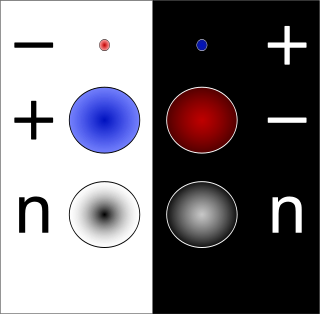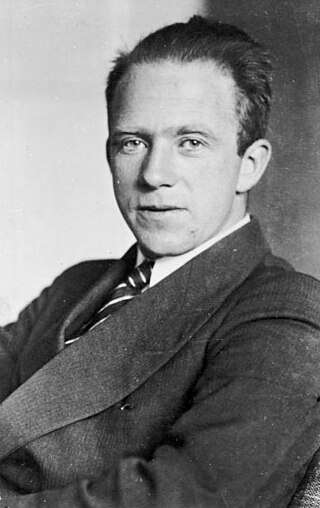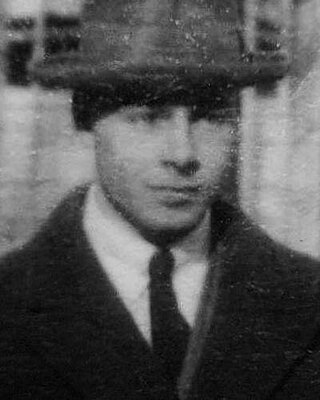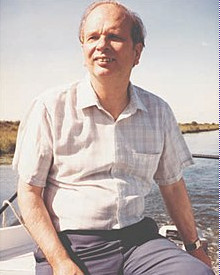
In particle physics, every type of particle of "ordinary" matter is associated with an antiparticle with the same mass but with opposite physical charges. For example, the antiparticle of the electron is the positron. While the electron has a negative electric charge, the positron has a positive electric charge, and is produced naturally in certain types of radioactive decay. The opposite is also true: the antiparticle of the positron is the electron.

The Einstein–Podolsky–Rosen (EPR) paradox is a thought experiment proposed by physicists Albert Einstein, Boris Podolsky and Nathan Rosen which argues that the description of physical reality provided by quantum mechanics is incomplete. In a 1935 paper titled "Can Quantum-Mechanical Description of Physical Reality be Considered Complete?", they argued for the existence of "elements of reality" that were not part of quantum theory, and speculated that it should be possible to construct a theory containing these hidden variables. Resolutions of the paradox have important implications for the interpretation of quantum mechanics.

The positron or antielectron is the particle with an electric charge of +1e, a spin of 1/2, and the same mass as an electron. It is the antiparticle of the electron. When a positron collides with an electron, annihilation occurs. If this collision occurs at low energies, it results in the production of two or more photons.

Werner Karl Heisenberg was a German theoretical physicist, one of the main pioneers of the theory of quantum mechanics, and a principal scientist in the Nazi nuclear weapons program during World War II. He published his Umdeutung paper in 1925, a major reinterpretation of old quantum theory. In the subsequent series of papers with Max Born and Pascual Jordan, during the same year, his matrix formulation of quantum mechanics was substantially elaborated. He is known for the uncertainty principle, which he published in 1927. Heisenberg was awarded the 1932 Nobel Prize in Physics "for the creation of quantum mechanics".
A wormhole is a hypothetical structure connecting disparate points in spacetime, and is based on a special solution of the Einstein field equations.

Anti-gravity is a hypothetical phenomenon of creating a place or object that is free from the force of gravity. It does not refer to either the lack of weight under gravity experienced in free fall or orbit, or to balancing the force of gravity with some other force, such as electromagnetism and aerodynamic lift. Anti-gravity is a recurring concept in science fiction. Examples are the gravity blocking substance "Cavorite" in H. G. Wells's The First Men in the Moon and the Spindizzy machines in James Blish's Cities in Flight.

Willis Eugene Lamb Jr. was an American physicist who won the Nobel Prize in Physics in 1955 "for his discoveries concerning the fine structure of the hydrogen spectrum." The Nobel Committee that year awarded half the prize to Lamb and the other half to Polykarp Kusch, who won "for his precision determination of the magnetic moment of the electron." Lamb was able to precisely determine a surprising shift in electron energies in a hydrogen atom. Lamb was a professor at the University of Arizona College of Optical Sciences.

Hugh Everett III was an American physicist who, in his 1957 PhD thesis, proposed what is now known as the many-worlds interpretation (MWI) of quantum mechanics.

Llewellyn Hilleth Thomas was a British physicist and applied mathematician. He is best known for his contributions to atomic and molecular physics and solid-state physics. His key achievements include calculating relativistic effects on the spin-orbit interaction in a hydrogen atom, creating an approximate theory of -body quantum systems, and devising an efficient method for solving tridiagonal system of linear equations.
Quantum mechanics is the study of matter and its interactions with energy on the scale of atomic and subatomic particles. By contrast, classical physics explains matter and energy only on a scale familiar to human experience, including the behavior of astronomical bodies such as the moon. Classical physics is still used in much of modern science and technology. However, towards the end of the 19th century, scientists discovered phenomena in both the large (macro) and the small (micro) worlds that classical physics could not explain. The desire to resolve inconsistencies between observed phenomena and classical theory led to a revolution in physics, a shift in the original scientific paradigm: the development of quantum mechanics.
Otto Laporte was a German-born American physicist who made contributions to quantum mechanics, electromagnetic wave propagation theory, spectroscopy, and fluid dynamics. His name is lent to the Laporte rule in spectroscopy and to the Otto Laporte Award of the American Physical Society.

Yuri Borisovich Rumer was a Soviet theoretical physicist, who mostly worked in the fields of quantum mechanics and quantum optics. Known in the West as Georg Rumer, he was a close friend of Lev Landau, and was arrested with him during the Great Purge in 1938.

LotharWolfgang Nordheim was a German born Jewish American theoretical physicist. He was a pioneer in the applications of quantum mechanics to solid-state problems, such as thermionic emission, work function of metals, field electron emission, rectification in metal-semiconductor contacts and electrical resistance in metals and alloys. He also worked in the mathematical foundations of quantum mechanics, cosmic rays and in nuclear physics.
Richard Lawrence Liboff was an American physicist who authored five books and over 100 other publications in variety of fields, including plasma physics, planetary physics, cosmology, quantum chaos, and quantum billiards.
Carl Henry Eckart was an American physicist, physical oceanographer, geophysicist, and administrator. He co-developed the Wigner–Eckart theorem and is also known for the Eckart conditions in quantum mechanics, the Eckart–Young theorem in linear algebra., and his work on non-equilibrium thermodynamics and continuum mechanics, including a relativistic treatment
Eugene Feenberg was an American physicist who made contributions to quantum mechanics and nuclear physics.
Reinhard Oehme was a German-American physicist known for the discovery of C non-conservation in the presence of P (parity) violation, the formulation and proof of hadron dispersion relations, the "Edge of the Wedge Theorem" in the function theory of several complex variables, the Goldberger-Miyazawa-Oehme sum rule, reduction of quantum field theories, Oehme-Zimmermann superconvergence relations for gauge field correlation functions, and many other contributions.

Edwin Albert Power was an English physicist and an emeritus professor of applied mathematics at University College London. He made several contributions to the field of non-relativistic quantum electrodynamics.
Lucien Hardy is a British-Canadian theoretical physicist currently based at the Perimeter Institute for Theoretical Physics in Waterloo, Canada.

Paul Anthony Benioff was an American physicist who helped pioneer the field of quantum computing. Benioff was best known for his research in quantum information theory during the 1970s and 80s that demonstrated the theoretical possibility of quantum computers by describing the first quantum mechanical model of a computer. In this work, Benioff showed that a computer could operate under the laws of quantum mechanics by describing a Schrödinger equation description of Turing machines. Benioff's body of work in quantum information theory encompassed quantum computers, quantum robots, and the relationship between foundations in logic, math, and physics.












